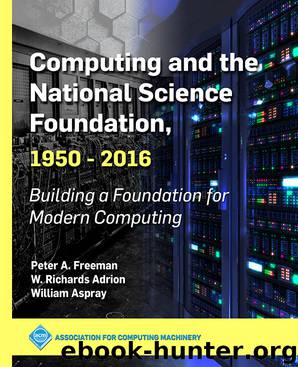Computing and the National Science Foundation, 1950–2016 by Peter A. Freeman W. Richards Adrion and William Aspray

Author:Peter A. Freeman, W. Richards Adrion and William Aspray
Language: eng
Format: epub
Publisher: Association for Computing Machinery
6.3.4Building the National Computer Science Community
Before turning to an examination of the Foundation’s role in developing a curriculum for computing, this section presents the national context for the development of computer science and the role of the universities in training computer scientists. As we will see, the Foundation’s role was primarily to support the efforts of professional societies and individual universities in these curricular efforts, as well as to play a coordinating role for the emerging computer science community. Those topics are discussed in detail in the next section.
Some of the earliest computers were built on university campuses, and it was those universities that taught the first computer courses: Harvard, MIT, and the University of Pennsylvania were already teaching computing courses in the late 1940s, and by the early 1950s they were joined by UCLA and Berkeley. Computing courses were originally taught only at the graduate level because the equipment was too expensive and too scarce for masses of undergraduates. MIT, which had begun graduate instruction in computing in 1947, offered its first undergraduate computing course in 1953—probably the first undergraduate computing course in the United States.
Early computing courses included mathematical topics, especially numerical analysis, and electronic engineering topics such as switching circuits. As more universities began to offer computing instruction in the 1950s, the instructional programs tended to fall into one of two categories. Some universities established computing centers, and these centers offered practical instruction in how to use computing equipment. Examples included the Wayne University Computation Laboratory, the University of Michigan’s Willow Run Research Center, Georgia Tech’s Rich Electronic Computing Center, the University of Illinois Computation Laboratory, and Purdue’s Computation Laboratory. At other universities, however, either electrical engineering or mathematics departments offered introductory courses in logical design, programming, or applications—often even before the university had acquired its own computing equipment. By the mid-1950s, other academic units, such as business schools and agronomy departments, were beginning to offer computing courses. A 1954 survey by the Institute of Radio Engineers of 68 universities conducting some activity in digital or analog computing found 29 were offering at least one computing course—and of these, 9 were offering three or more courses.72
Already by 1954 there were discussions about the directions for computing instruction. Howard Aiken, the director of Harvard’s Computation Laboratory and an early leader in computer education, argued for a broad education, of both “so-ciology and computing devices.”73 F. Joachim Weyl, Director of the Office of Naval Research (ONR) Mathematical Sciences Division, argued that broad computer instruction was urgent:
an unprecedented mathematization; not only of fundamental scientific research in the physical and biological sciences but also in the management of our industrial and social systems. This is about to assign to mathematics an entirely new part in our civilization with far-reaching implications on what should be taught, how it should be taught and to whom.74
Throughout the 1950s and the early 1960s, the Foundation made no concerted effort to develop computer science and computer engineering curricula. As the 1960s went on, however, the Foundation
Download
This site does not store any files on its server. We only index and link to content provided by other sites. Please contact the content providers to delete copyright contents if any and email us, we'll remove relevant links or contents immediately.
Algorithms of the Intelligent Web by Haralambos Marmanis;Dmitry Babenko(8532)
Test-Driven Development with Java by Alan Mellor(7448)
Data Augmentation with Python by Duc Haba(7335)
Principles of Data Fabric by Sonia Mezzetta(7084)
Learn Blender Simulations the Right Way by Stephen Pearson(7028)
Microservices with Spring Boot 3 and Spring Cloud by Magnus Larsson(6843)
RPA Solution Architect's Handbook by Sachin Sahgal(6257)
Hadoop in Practice by Alex Holmes(6039)
The Infinite Retina by Robert Scoble Irena Cronin(5961)
Jquery UI in Action : Master the concepts Of Jquery UI: A Step By Step Approach by ANMOL GOYAL(5878)
Big Data Analysis with Python by Ivan Marin(5749)
Life 3.0: Being Human in the Age of Artificial Intelligence by Tegmark Max(5410)
Pretrain Vision and Large Language Models in Python by Emily Webber(4708)
Infrastructure as Code for Beginners by Russ McKendrick(4489)
WordPress Plugin Development Cookbook by Yannick Lefebvre(4215)
Functional Programming in JavaScript by Mantyla Dan(4129)
The Age of Surveillance Capitalism by Shoshana Zuboff(4127)
Embracing Microservices Design by Ovais Mehboob Ahmed Khan Nabil Siddiqui and Timothy Oleson(4009)
Applied Machine Learning for Healthcare and Life Sciences Using AWS by Ujjwal Ratan(3985)
